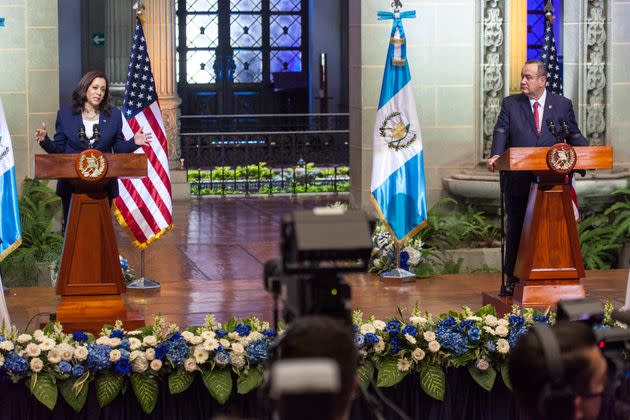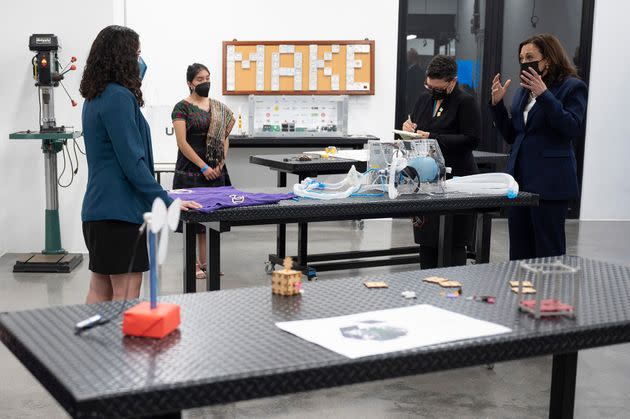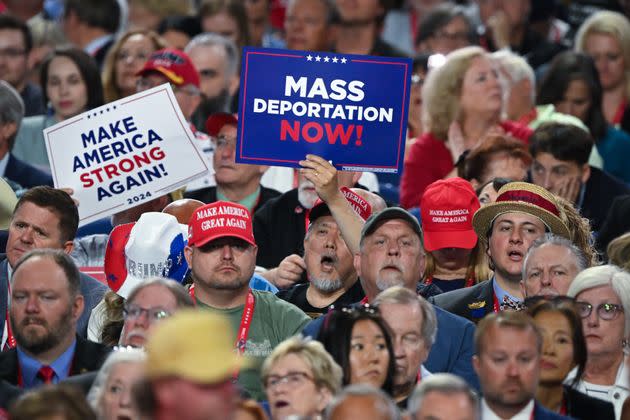Here's The Real Story Of Kamala Harris On Immigration
- Oops!Something went wrong.Please try again later.
- Oops!Something went wrong.Please try again later.
- Oops!Something went wrong.Please try again later.
It would be wrong to say the attacks on Vice President Kamala Harris’ record as “border czar” began the moment Joe Biden withdrew from the 2024 campaign.
That’s because the attacks began long ago.
Ever since a spring 2021 White House meeting when Biden announced he was asking Harris to take the lead on a major immigration initiative, the vice president has been the face of the administration’s response to migration at the Southern border. As crossings have surged, Harris has taken the blame for policies that Republican lawmakers ― and many voters ― say have been a disaster.
You can see the toll on her reputation in a late July YouGov poll: Just 30% of voters said they trusted her over Donald Trump on immigration. And Republicans are hard at work making sure that reputation sticks.
“As a result of her dangerously extreme immigration policies, the largest invasion in history is now taking place at our southern border,” Trump said on a Tuesday conference call for reporters.
The day before, the Republican National Committee had distributed a press release and video of the 2021 White House meeting. “Here is the moment Biden crowned Kamala ‘border czar’ in 2021,” the RNC posted on its official X (formerly Twitter) account.
But if you actually watch that video, you’ll notice something: Biden never called Harris a “border czar,” or even implied she’ll be taking the lead for administration policy. As the full meeting transcript makes clear, he was simply tapping Harris to work with foreign governments, businesses and local organizations on the “root causes” of migration from the “Northern Triangle” countries of El Salvador, Guatemala and Honduras.
“She was not in charge of what happened at the U.S.-Mexico border. She was not a border czar,” Theresa Cardinal Brown, director of immigration policy at the Bipartisan Policy Center, told HuffPost.
That doesn’t mean Harris can ― or should ― avoid questions about Biden administration immigration policy. She has been a voice in the room. And given the positions she took before becoming vice president, it’s entirely possible she would have taken a similar approach to the border had she, not Biden, been the ultimate decision maker.
But a fair analysis of Harris’ record should start with a look at how she carried out her real mission, rather than the mythical job of border czar. The picture that emerges ― based in part on conversations with a half dozen analysts ― looks quite a bit different from the one Republicans have been painting. It also offers some important clues about how she might govern if she wins in November.
Why Immigration Policy Has Been So Difficult
To understand what Biden asked Harris to do in 2021, it helps to understand the situation he inherited when he took over as president. That story actually goes back to when he was vice president, when a then-unprecedented surge of migrants at the Southern border overwhelmed public and private resources in 2014, creating chaos.
Unlike previous waves of immigrants, who were predominantly men from Mexico looking to find work while avoiding authorities, this group had large numbers of women and (frequently unaccompanied) children hoping to stay in the U.S. using the legal asylum process. And they were from those Northern Triangle countries, not Mexico.
As officials tried desperately to figure out how to process these migrants through a system never designed to accommodate them, then-President Barack Obama dispatched Biden to address what he and his advisers believed were the underlying forces prompting so many people to leave their home countries in the first place.
These “root causes” included not just a lack of economic opportunity but also high rates of gang violence. Both problems had defied attempts at redress because of rampant government corruption in the Triangle nations, making political reform in those countries an important part of the job. Violence against children and women was another concern, because it’s what made conditions so deplorable that women were willing to risk their lives or send their children away with smugglers.
With Biden taking the lead, the Obama administration sent more aid to the Northern Triangle countries. But they had only two years, and Trump, whose singular focus was on stopping migrants at the border, cut the assistance and scaled back other efforts to make it easier to process refugees. When Biden became president, he restarted the initiatives and handed his old portfolio to Harris.

The political risks of taking on the famously intractable challenge of immigration were so obvious that “Saturday Night Live” even made a joke about it. And although Harris was familiar with immigration from her work in California politics, she had never really operated at such a national and international level, with every utterance subject to such scrutiny both at home and abroad.
The inexperience showed. During a visit to Guatemala, she gave an unusually blunt speech warning migrants not to come to the U.S. Her comments infuriated progressives like Rep. Alexandria Ocasio-Cortez (D-N.Y.), who said on social media that discouraging refugees seeking asylum was unfair after the U.S. “spent decades contributing to regime change and destabilization in Latin America.”
In an interview on NBC, Harris gave a fumbling answer about visiting the border that conservatives cited as proof she didn’t take the migration surge seriously. “The vice president thinks the border crisis is a hilarious joke,” said Kevin McCarthy, the California Republican who at the time was leader of the House Republicans.
The timing was terrible, too. The speech and the quote came right as the Biden administration was reversing many of Trump’s more aggressive border policies and as COVID-19 was receding, allowing freer movement among nations again. Because of the former, the latter or some combination of the two — it depends on whose analysis you believe — migration from the Northern Triangle shot up again.
It was Biden, not Harris, making these decisions. But Biden’s change in policy was consistent with the approach to immigration most high-profile Democratic leaders had been endorsing for years, including during the 2020 presidential primaries — when Harris, who was a candidate, said, “We must fundamentally overhaul our immigration enforcement policies and practices” in order to end Trump’s “cruel and out-of-control” approach.
In just the last year, and in response to the new surge, the Biden administration has once again tightened border security while also trying to improve processing of refugee applications. Border crossings have fallen sharply, back to levels not seen since 2020, though that has not calmed the political waters.
Progressives have denounced what they call “harmful deterrent-based policies,” while MAGA Republicans think Democrats aren’t doing enough. (Trump on his Tuesday press call described it as a “Band-Aid.”) Meanwhile, polls continue to show immigration is the single worst issue for Democrats — and for Harris in particular.
What Harris Actually Did
Some advocates and analysts, especially on the right, see the root-causes strategy as a distraction or worse, arguing that it “will waste American tax dollars, and will perpetuate current pull factors of illegal immigration,” as a 2021 Heritage Foundation report put it.
Andrew Selee, president of the Migration Policy Institute, told HuffPost he is more optimistic, arguing the approach “could make a huge difference down the road.” But, he warned, “the chance that this could make a big difference in two or three years, or even in eight, in two terms as a president … it’s hard to see how it would.”
Jason Marczak, vice president and senior director of the Atlantic Council’s Adrienne Arsht Latin America Center, said it’s unrealistic to expect quicker progress from the root-causes effort, as Harris herself warned when she took on the task. “The factors leading up to the migration from these three countries, they didn’t start last year, two years ago, five or even 10 years ago — they go back decades,” Marczak said.
There’s also the inherent difficulty of trying to work on root causes in countries where the government is not a particularly helpful partner, because of corruption, incompetence or both.

Harris’ efforts have included showing U.S. support for reformers like Guatemala’s newly elected president, who ran on an anti-corruption platform. And that’s helped, said Brown, who worked on border issues while serving in the administration of George W. Bush.
At the same time, Brown said, “some of those are things that the United States really can’t fix for these countries. They have to kind of fix it on their own, maybe with some help and encouragement and support.”
But if it’s too early to assess the effects of the root-causes strategy, it’s not too early to see where Harris’ efforts have made a mark, several advocates and analysts said.
Cecilia Muñoz, a veteran political leader in the Latino political community, cited the establishment of “safe mobility centers” in Central and South America, starting in Guatemala, so that potential migrants can seek permission to enter the U.S. without making the treacherous, smuggler-led journey to the Mexico border.
“Setting up migration offices that involve multiple countries and multiple international organizations is an enormously complex exercise,” said Muñoz, who worked on immigration while serving as a domestic policy adviser in the Obama White House. “It is tremendously important to have a principal of the vice president’s caliber leading the charge, engaging with heads of state, and managing the collaboration between the many federal agencies in the United States who need to be involved in that process.”
That kind of high-level negotiation also helped secure more than $5 billion in regional investment from multinational companies like Apple and Starbucks, Muñoz and some of the other analysts said. And while Harris’ speech and the NBC interview got the most public scrutiny during her 2021 Guatemala trip, what some regional experts noticed was the vice president’s itinerary there — and how it reflected the expertise, if not the experience, she brought to the job.
“She made sure that she wasn’t just meeting with the corrupt administration there,” Marshall Fitz, managing director of immigration at the Emerson Collective, said of her trip. “She was also meeting directly with Indigenous women, engaging them, making sure she heard them and saw them. One of her niches is women’s empowerment generally, and her understanding of migration is very much rooted in an understanding that if you’ve going to solve these migration challenges, women are going to be a big part of that because they’re the backbones of these families.”
Vicki Gass, a former Oxfam official who is now executive director of the Latin American Working Group, also took note of Harris’ focus on gender-based violence as a key factor in migration. “She was genuine, she was concerned,” Gass said of the vice president’s efforts in Central America. “She was specifically, especially concerned about gender-based violence and issues surrounding children and youth, youth violence, access to education.”
But Gass was skeptical that other parts of the root-causes effort would pay off. She said she thought Harris and her team didn’t understand “how endemic corruption — and class and hierarchy — are to these countries.” She also thought the celebrated $5 billion corporate investment won’t do much for true economic development, which would require more serious investments in things like education and skills training.
“The corporations get gold stars for being in this partnership and committing money,” Gass said, “but actually it’s more of a marketing thing, and doesn’t address the issues on the ground.”
Others were more sanguine, saying the root causes strategy as a whole could pay off — if, and only if, it continues to get support from the White House. “I think that in order to have a kind of sustainable, long-term drop in migration from these countries, it’s going to require a continuity of these efforts — you know, beyond one administration,” Marczak said.
“The challenge is that this kind of a strategy is not a short-term strategy,” Brown said. “She did get quite a few private-sector commitments of investment in these countries. But turning that investment into actual jobs ― it’s harder getting that investment actually deployed and doing something. It’s just a long-term thing.”
What Policy Could Look Like After The Election
Another factor limiting the impact of Harris’ efforts is that the surge of migrants that caused border crossings to spike earlier in Biden’s presidency doesn’t look like previous surges.
That’s because the new wave of migrants has been coming from South American countries and the Caribbean, and sometimes from much further, with different forces pushing the exoduses from different regions. Migrants from the Northern Triangle, meanwhile, are actually down, though they still represent a significant part of the flow.
The other big problem, which the Obama administration also confronted during the 2014 surge, is that the U.S. immigration system is simply not designed to police and process such large numbers of migrants seeking asylum status, especially when so many are women and children.

For most Democrats and at least some Republicans, the best policy response would be legislation simultaneously increasing security and increasing the capacity for processing migrants trying to enter legally — and, in some fashion, dealing with the estimated 11 million undocumented immigrants already in the U.S.
Twice in the last decade, Congress has come close to passing such legislation on a bipartisan basis. Both times, anti-immigration Republicans killed it.
A Trump win would all but preclude the possibility of such reforms. He has instead promised that he would focus on the “largest deportation in history,” using (legally dubious) authority to protect national security and enlisting police and the National Guard to carry out raids across the country.
A Harris win would keep a proponent of reform legislation in the White House, though her ability to deliver it would obviously depend on her negotiating skills and which party controls Congress. In the meantime, it’s safe to assume Harris would likely use her executive authority over border enforcement by trying ― as Biden did — to find some sort of middle path that blends tighter border controls with new methods for processing migrants. And she’d probably keep paying attention to root causes, in Central America and maybe beyond.
Such an approach certainly wouldn’t solve the problems associated with immigration in a single year, or even a single presidential term. It’d inevitably change to match circumstances, sometimes suddenly, with high-profile setbacks to go with quiet advances. But considering immigration’s complexity, and what’s actually feasible as policy and politics today, Harris could make a credible case there’s no better alternative.
CORRECTION: A previous version of this story misspelled Vicki Gass’ name.
Related...
Pennsylvania Gov. Josh Shapiro Hyped As Possible Kamala Harris Running Mate
James Carville Delivers Stark Warning To Buoyant Democrats Over Kamala Harris
Kayleigh McEnany Drops Puzzling Read Of Kamala Harris: ‘Everyone Needs To Be Prepared’
‘I Approve This Message’: Kamala Harris Instantly Uses Trump’s Own Words Against Him
